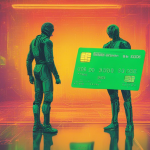Tokenization 2.0: The Cutting-Edge Solution for Efficient Asset Management

Introduction to Tokenization
Tokenization is a process that involves the representation of real-world assets as digital tokens on a blockchain network. These tokens are cryptographic in nature and carry the value and ownership of the underlying assets. By digitizing assets, tokenization offers various advantages such as increased efficiency, transparency, and accessibility.
Evolution and significance of tokenization in asset management
Tokenization has evolved significantly over the years, transforming the way assets are managed. Initially, tokenization was limited to basic representations of assets on blockchains. However, with the advent of Tokenization 2.0, asset management has become more efficient and streamlined. This new wave of tokenization integrates advanced features and technologies that revolutionize traditional asset management practices.
Traditional Asset Management Challenges
Limitations and inefficiencies in traditional asset management systems
Traditional asset management often faces challenges related to liquidity, fragmentation, and operational inefficiencies. In traditional systems, asset ownership is often cumbersome and restricted, resulting in illiquid markets. Moreover, the lack of standardization and interoperability makes it difficult to exchange assets seamlessly across different platforms.
Lack of liquidity and accessibility in asset markets
Tokenization 2.0 addresses the liquidity issues faced by traditional asset management by fractionalizing the ownership of assets. Through tokenization, assets can be divided into smaller units, enabling fractional ownership and facilitating easier and faster transactions. This increased liquidity enhances market accessibility, allowing a broader range of investors to participate.
Regulatory and compliance hurdles in asset management
Compliance with various regulatory frameworks is a critical aspect of asset management. Traditional systems are burdened with complex and time-consuming compliance processes, which can lead to delays and increased costs. Tokenization 2.0 leverages blockchain technology’s immutability and transparency to streamline compliance procedures, ensuring regulatory compliance in a more efficient and secure manner.
Understanding Tokenization 2.0
Tokenization 2.0 represents the next phase of evolution in asset tokenization. It builds upon the foundation laid by traditional tokenization but introduces significant improvements. Tokenization 2.0 incorporates advanced features like smart contracts and decentralized technologies, enabling enhanced security, scalability, and interoperability.
Blockchain technology as the foundation for Tokenization 2.0
Blockchain technology serves as the underlying infrastructure for Tokenization 2.0. Its decentralized and distributed nature ensures data integrity and transparency. By utilizing blockchain networks, tokenization platforms can offer secure and efficient asset management solutions, eliminating the need for intermediaries and reducing costs.
Role of smart contracts in enabling secure digital asset representation
Smart contracts play a pivotal role in Tokenization 2.0 by automating the execution and enforcement of contractual agreements. These self-executing contracts facilitate secure digital asset representation and enable automated processes such as dividend distributions, governance protocols, and regulatory compliance. Smart contracts enhance transparency, efficiency, and trust, contributing to the overall effectiveness of Tokenization 2.0.
Benefits of Tokenization 2.0 in Asset Management
Increased liquidity and fractional ownership through tokenization
Tokenization 2.0 breaks down traditional asset units into digital tokens, enabling fractional ownership. This fractionalization enhances liquidity by allowing investors to purchase smaller portions of assets. It opens up investment opportunities, particularly for retail investors, who can now access and participate in previously illiquid markets.
Enhanced market accessibility and reduced barriers to entry
Tokenization 2.0 lowers the barriers to entry for asset markets, democratizing investment opportunities. Fractional ownership and smaller investment sizes enable a broader range of investors to participate. Additionally, tokenization improves market accessibility by enabling asset trading and transferability across platforms, eliminating geographical restrictions.
Improved transparency, security, and auditability of asset ownership
Tokenization 2.0 leverages blockchain’s inherent transparency to provide a verifiable record of ownership and transaction history. Immutable and auditable, blockchain-based asset records reduce the potential for fraud and ensure the accuracy of ownership information. This enhanced transparency and security foster trust among investors and eliminate the need for intermediaries.
Applications of Tokenization 2.0 in Asset Management
Real estate tokenization revolutionizing property investment
Tokenization 2.0 has disrupted the real estate industry by transforming the way properties are bought and sold. By tokenizing real estate assets, property ownership can be divided into digital tokens, enabling fractional ownership and providing liquidity to traditionally illiquid markets. Investors can now participate in real estate investments without the need for large capital commitments.
Tokenization of securities and stocks transforming traditional markets
Tokenization 2.0 is revolutionizing the world of finance by digitizing traditional securities and stocks. This process enables the issuing and trading of tokenized securities on blockchain platforms. By tokenizing securities, market participants benefit from increased liquidity, faster settlement, and improved accessibility to a global investor base.
Tokenization of alternative assets like art, collectibles, and intellectual property
Tokenization 2.0 extends beyond traditional financial assets, allowing for the tokenization of alternative assets like art, collectibles, and intellectual property. By converting these assets into digital tokens, previously illiquid markets become more accessible, enabling investors to diversify their portfolios and participate in niche markets.
Tokenization 2.0 and Decentralized Finance (DeFi)
Interplay between Tokenization 2.0 and the DeFi ecosystem
Tokenization 2.0 complements the booming ecosystem of Decentralized Finance (DeFi). The ability to tokenize assets opens up opportunities for asset-backed lending, decentralized trading platforms, and liquidity provision through decentralized exchanges (DEXs). Tokenization 2.0 enables seamless integration of assets into DeFi protocols, creating new avenues for capital formation and investment.
Leveraging tokenized assets in DeFi lending and borrowing protocols
Tokenized assets can be utilized as collateral in DeFi lending and borrowing protocols. By tokenizing assets, their value can be transparently represented on blockchain networks. This representation allows for the creation of decentralized lending platforms, where users can borrow against their tokenized assets without intermediaries. Tokenization 2.0 thus empowers individuals to access capital more efficiently and at potentially lower costs.
Implications of DeFi for traditional financial intermediaries
The rise of Tokenization 2.0 and DeFi poses challenges for traditional financial intermediaries. With direct peer-to-peer transactions and automated processes enabled by smart contracts, intermediaries such as custodians, brokers, and clearinghouses may see reduced demand for their services. However, these intermediaries can adapt by exploring opportunities to integrate and collaborate within the tokenization and DeFi ecosystem.
Overcoming Challenges in Implementing Tokenization 2.0
Regulatory considerations and legal frameworks for tokenized assets
The implementation of Tokenization 2.0 requires navigating through various regulatory considerations and legal frameworks governing digital assets. Regulators are actively addressing the challenges associated with tokenization, such as investor protection, anti-money laundering, and securities regulations. Harmonizing regulatory frameworks globally will be crucial for the widespread adoption of tokenized assets.
Addressing security and fraud risks in tokenized asset management systems
Tokenization 2.0 brings new security challenges with the digitization of assets. Safeguarding private keys, securing smart contracts, and protecting against unauthorized access are critical for maintaining the integrity and security of tokenized assets. Implementing robust security measures, including multi-factor authentication, encryption, and regular audits, will be essential in mitigating potential risks.
Building trust and adoption among investors and traditional financial institutions
To drive widespread adoption, Tokenization 2.0 must establish trust and confidence among both investors and traditional financial institutions. Demonstrating the benefits of tokenization, including increased liquidity, transparency, and efficiency, will be key in encouraging participation. Additionally, educating stakeholders about the technology, addressing concerns, and fostering collaboration across industries will bolster the adoption of Tokenization 2.0.
Future Outlook for Tokenization 2.0
Emerging trends and advancements in tokenization technology
The future of Tokenization 2.0 holds immense potential for further advancements and innovation. Emerging trends include the integration of artificial intelligence and machine learning in asset management processes, the development of interoperability standards across tokenization platforms, and the exploration of scalable blockchain solutions to accommodate growing demand.
Impact of Tokenization 2.0 on the traditional asset management industry
Tokenization 2.0 represents a significant disruption to traditional asset management practices. With enhanced liquidity, fractional ownership, and increased accessibility, traditional financial institutions will need to adapt and explore opportunities in the tokenization space. Embracing blockchain technology and evolving their business models will be crucial for remaining competitive in the changing landscape of asset management.
Potential disruptions and opportunities in the financial landscape
Tokenization 2.0 has the potential to disrupt various sectors within the financial landscape. By enabling fractional ownership and enhancing liquidity, tokenization can democratize investment opportunities, provide alternative funding mechanisms, and facilitate cross-border transactions. Additionally, the integration of tokenized assets with DeFi protocols may reshape the way individuals access financial services and create new avenues for innovation.
Case Studies: Successful Implementations of Tokenization 2.0
Case study 1: Tokenization of a commercial real estate project
In this case study, a commercial real estate project successfully utilizes Tokenization 2.0 to transform the way properties are financed and traded. Through the tokenization process, the property is divided into digital tokens, allowing fractional ownership and easier access to investors. This approach enhances liquidity, reduces barriers to entry, and provides investors with new investment opportunities.
Case study 2: Tokenized securities issuance and trading platform
This case study explores a tokenized securities platform that enables the issuance and trading of various financial assets on a blockchain network. By tokenizing these assets, the platform improves liquidity, speeds up settlement times, and enables global access to investors. This successful implementation demonstrates the transformative power of Tokenization 2.0 in traditional financial markets.
Case study 3: Tokenizing alternative assets for investment diversification
This case study focuses on the tokenization of alternative assets such as art, collectibles, and intellectual property. By converting these traditionally illiquid assets into digital tokens, Tokenization 2.0 opens up new investment opportunities and allows for diversification. Investors can now participate in these markets, previously reserved for a select few, offering potential returns and portfolio diversification.
Concluding Words
Tokenization 2.0 represents a game-changing solution for efficient asset management. By leveraging blockchain technology, smart contracts, and fractional ownership, tokenization transforms traditional asset structures and processes. The benefits of Tokenization 2.0 include increased liquidity, enhanced market accessibility, and improved transparency and security. While regulatory challenges and security risks need to be addressed, the widespread adoption of Tokenization 2.0 holds promises for a more inclusive and efficient financial landscape.
FAQs (Frequently Asked Questions)
What is asset tokenization?
Asset tokenization is the process of digitally representing real-world assets as tokens on a blockchain network. This digitization enhances liquidity, accessibility, and efficiency in asset management.
How does Tokenization 2.0 differ from traditional tokenization?
Tokenization 2.0 builds upon traditional tokenization by incorporating advanced features such as smart contracts and decentralized technologies. This evolution enables improved security, scalability, interoperability, and integration with decentralized finance (DeFi).
What are the main benefits of Tokenization 2.0 in asset management?
Tokenization 2.0 offers increased liquidity, fractional ownership, enhanced market accessibility, improved transparency, security, and auditability of asset ownership. These benefits empower a broader range of investors to participate in previously illiquid markets.
Which industries are adopting Tokenization 2.0?
Tokenization 2.0 is being adopted across various industries, including real estate, securities, art, collectibles, intellectual property, and more. Its benefits apply to any asset that can be digitized and represented as a token.
What role does blockchain technology play in Tokenization 2.0?
Blockchain technology serves as the foundation for Tokenization 2.0, ensuring transparent and secure transactions. It enables the creation of tamper-resistant asset records, facilitates decentralized asset trading, and eliminates the need for intermediaries.
What are the regulatory considerations for tokenized assets?
The implementation of tokenized assets requires compliance with existing regulatory frameworks governing securities, anti-money laundering, investor protection, and more. Harmonizing these regulations globally is crucial for the widespread adoption of tokenization.
How does Tokenization 2.0 impact the DeFi ecosystem?
Tokenization 2.0 complements the DeFi ecosystem by providing asset-backed tokens that can be used as collateral, enhancing liquidity and expanding the capabilities of decentralized lending, borrowing, and trading protocols.
Are there any successful real-world implementations of Tokenization 2.0?
Yes, there are several successful implementations of Tokenization 2.0 in various industries. Examples include the tokenization of commercial real estate projects, platforms for tokenized securities issuance and trading, and the tokenization of alternative assets like art and intellectual property.
What challenges need to be addressed for widespread adoption of Tokenization 2.0?
Challenges that need to be addressed include regulatory considerations, security risks, and building trust among investors and traditional financial institutions. Education, collaboration, and the development of robust security measures are crucial for widespread adoption.
What does the future hold for Tokenization 2.0 in asset management?
The future of Tokenization 2.0 looks promising. Advancements in technology, the integration of AI and machine learning, and the evolution of interoperability standards will drive further innovation. Tokenization 2.0 will continue to transform the asset management industry, creating new opportunities and reshaping financial landscapes.









